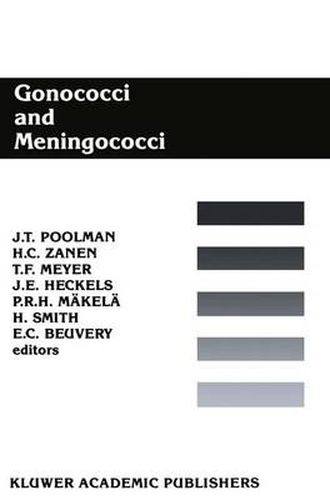Readings Newsletter
Become a Readings Member to make your shopping experience even easier.
Sign in or sign up for free!
You’re not far away from qualifying for FREE standard shipping within Australia
You’ve qualified for FREE standard shipping within Australia
The cart is loading…






This title is printed to order. This book may have been self-published. If so, we cannot guarantee the quality of the content. In the main most books will have gone through the editing process however some may not. We therefore suggest that you be aware of this before ordering this book. If in doubt check either the author or publisher’s details as we are unable to accept any returns unless they are faulty. Please contact us if you have any questions.
The 5th Pathogenic Neisseriae Conference was held in Noordwijkerhout, The Netherlands, on 15-18 September 1986. It followed San Francisco - USA (1978), Hemavan - Sweden (1980), Montreal - Canada (1982), Asilomar - USA (1984). These conferences will continue to be held in the foreseeing future. The reason for this is because studying pathogenic Neisseriae enables research workers to look at many aspects of bacterial infectious diseases. These aspects include: - Epidemiology and vaccination (section 1) - Genetic aspects of antigenic diversity (section 2) - Outer membrane proteins and IgA-protease (section 3) - Lipopolysaccharides, H8 antigen and peptidoglycan (section ~) - The application of all this knowledge to study pathogenesis (section 5) N. gonorrhoeae has become an important model organism to study mucosal bacterial infectious diseases. Basic knowledge about the bacterial surface, gene- tics and physiology is linked to pathogenic mechanisms such as adhesion to and invasion of epithelial cells, interaction with complement and phagocytic cells and mucosal immune mechanisms. This will continue to be an important research field in the near future. N. meningitidis has become an important model organism to study the epide- miology of potentially epidemic bacterial diseases and against which new type of vaccines are being developed such as outer membrane protein vaccines. The above mentioned topics are covered by papers presented at The 5th Path- ogenic Neisseriae Conference, 1986. I would like to thank Marijke van de Nadort without whom it would have been much harder or even impossible to organize such a meeting.
$9.00 standard shipping within Australia
FREE standard shipping within Australia for orders over $100.00
Express & International shipping calculated at checkout
Stock availability can be subject to change without notice. We recommend calling the shop or contacting our online team to check availability of low stock items. Please see our Shopping Online page for more details.
This title is printed to order. This book may have been self-published. If so, we cannot guarantee the quality of the content. In the main most books will have gone through the editing process however some may not. We therefore suggest that you be aware of this before ordering this book. If in doubt check either the author or publisher’s details as we are unable to accept any returns unless they are faulty. Please contact us if you have any questions.
The 5th Pathogenic Neisseriae Conference was held in Noordwijkerhout, The Netherlands, on 15-18 September 1986. It followed San Francisco - USA (1978), Hemavan - Sweden (1980), Montreal - Canada (1982), Asilomar - USA (1984). These conferences will continue to be held in the foreseeing future. The reason for this is because studying pathogenic Neisseriae enables research workers to look at many aspects of bacterial infectious diseases. These aspects include: - Epidemiology and vaccination (section 1) - Genetic aspects of antigenic diversity (section 2) - Outer membrane proteins and IgA-protease (section 3) - Lipopolysaccharides, H8 antigen and peptidoglycan (section ~) - The application of all this knowledge to study pathogenesis (section 5) N. gonorrhoeae has become an important model organism to study mucosal bacterial infectious diseases. Basic knowledge about the bacterial surface, gene- tics and physiology is linked to pathogenic mechanisms such as adhesion to and invasion of epithelial cells, interaction with complement and phagocytic cells and mucosal immune mechanisms. This will continue to be an important research field in the near future. N. meningitidis has become an important model organism to study the epide- miology of potentially epidemic bacterial diseases and against which new type of vaccines are being developed such as outer membrane protein vaccines. The above mentioned topics are covered by papers presented at The 5th Path- ogenic Neisseriae Conference, 1986. I would like to thank Marijke van de Nadort without whom it would have been much harder or even impossible to organize such a meeting.